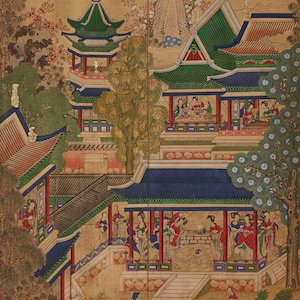Art of Asia
This site, an integrated, interactive media program, introduces users to the various arts of Asia. The site focuses on MIA’s extensive collections of Asian art, focusing on Chinese and Japanese art. Navigation is straightforward and begins on the main page where one can find links to three collections (”Buddhism,” “Architecture,” “Ceramics”). For each collection, there is a very useful search engine or you can browse chronologically through the collection.
This project grew from a website on art in Japan, so it comes as no surprise that the collection of Japanese art is the most extensive.with 2,237 objects featuring a large collection of Buddhist objects, traditional interiors, ukiyo-e woodblock prints, and architecture. A search engine to the Japanese collection, a fairly limited bibliography of ten Japanese art resources, and one basic map of contemporary Japan are also provided throughout the site.
The “Architecture” page boasts a section on “Two Japanese Rooms,” which provides a series of images of a formal audience hall (shoin) and a tea house (chashitsu) on the premises of the museum.
The collection of objects from China is the second-most extensive, with close to 1,000 objects. Other resources on China include a “Dynastic Guide” on Chinese art production; a search engine to the Chinese collection; a limited bibliography of 12 resources on Chinese art; and a useful set of 18 historical maps of China, past and present.
The “Dynastic Guide” is a wonderful introduction to the varieties of Chinese art production during 13 historical periods, from the Neolithic era (3000-1500 BCE) to the Qing dynasty (1644-1911 BCE). For each period, there is a video presentation by Curator Robert Jacobsen and an accompanying map (Flash required). Along the left side of each page are links to sample objects produced during the particular historical period under consideration.
The collection of objects from Tibet is rather limited and focuses on a single object known as the “Yamantaka Mandala”—a Tibetan sand painting made by monks from the Gyuto Tantric University when they visited Minneapolis in 1991. This page also includes a rather general and rudimentary map of Tibet.
This site is a very useful tool for introducing students to the methods, approaches, and questions that scholars and historians use to make sense of and contextualize material objects from the past.
